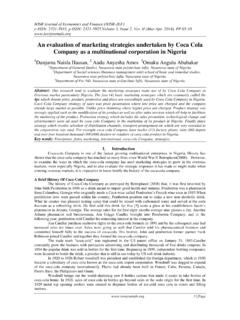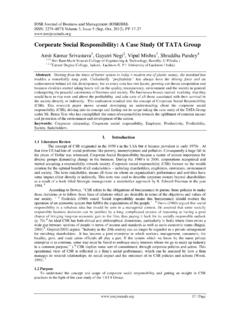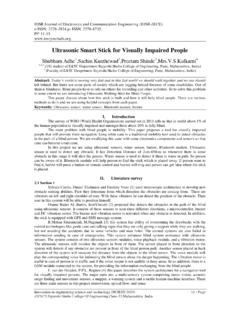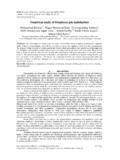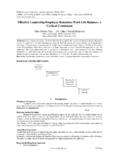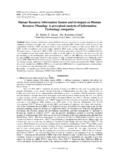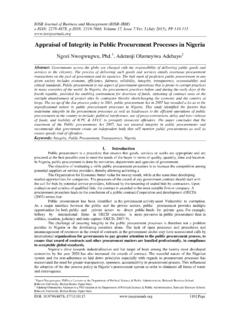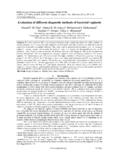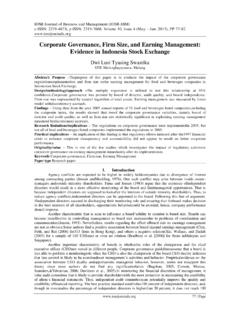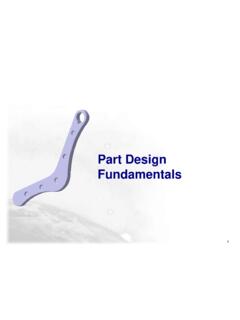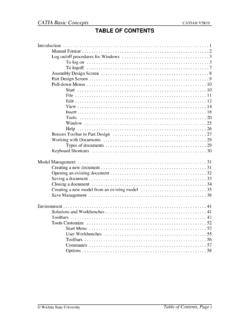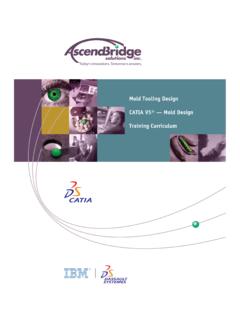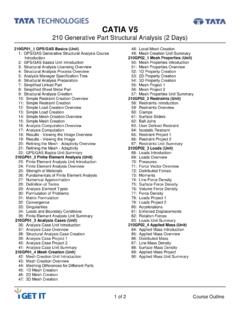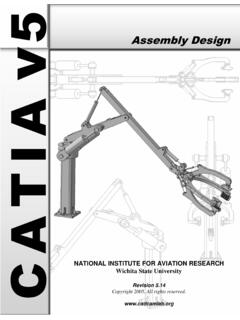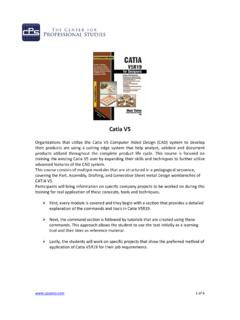Transcription of Electric car chassis design and analysis by using CATIA V5 R19
1 IOSR Journal of Mechanical and Civil Engineering (IOSR-JMCE) e-ISSN: 2278-1684,p-ISSN: 2320-334X, Volume 11, Issue 4 Ver. III (Jul- Aug. 2014), PP 56-59 56 | Page Electric car chassis design and analysis by using CATIA V5 R19 Ahmad Zainal Taufik1, Nur Rashid1, Mazlan1, Mohd Faruq1, Muhammad Zahir1 1 Universiti Teknikal Malaysia Melaka, Malaysia Abstract: The evolution of computer aided design (CAD) systems and related technologies has promoted the development of software for the east of chassis modeling. It visualizes the main outputs of the model, which consist in numeric data and graphic elements.
2 This reduces the simulation time dramatically and enables the optimization process to come to successful results. This paper presents an Electric car chassis design by using the commercial design software package, CATIA V5 R19. The design of the chassis with adequate stiffness and strength is the aim of this project. The material used is mild steel AISI 1018 with 386 MPa of yield strength and 634 MPa of ultimate strength. The result shows that the critical point of stress and displacement occurred in the middle of the side members in all loading conditions, maximum stresses are below the yield stress. The final products for the design have been fabricated successfully.
3 Keywords: Electric car, chassis design , CATIA V5 R19, Stress analysis , load analysis I. introduction Technical innovations in vehicle design , will play a very considerable role in the future in reducing emissions. Electric drive vehicles are becoming an attractive alternative to combustion engine cars with global gradual fossil fuel prices rise. In addition, increasing energy prices also have led to an increase interest in the development of Electric vehicles. In the European Union, the car manufacturers have agreed to an overall 25% increase in fuel efficiency by the year 2005 compared to 1990 [1]. In addition, concerns over climate change and reduction of greenhouse gas emissions, and dependence of economies on foreign energy sources, have also become an initiative for extensive research on the use of Electric cars as an alternative [2, 3, 4].
4 Quality has been one of the key issues for the automotive industry. The breakdown of Initial Quality Survey 1997 by [5] indicates that the problems related to body and dimensional quality count for up to 41% percent of the total problems. Cars with electrical drive systems represent a solution for the future, and will in a steadily increasing degree be seen on the roads. The history of Electric cars is closely related to the history of batteries [6, 7, 8]. Electric cars appear to be the most suitable candidates to fulfill the environmental demands. In Electric cars, efficiency of energy usage is very important.
5 In order for an Electric car to perform at its best it must have adequate structure, this means it must have a stiff frame. Since most of the car's weight is between the front and rear suspension, frame stiffness is absolutely the key between these points where it will not easily bend. For the Electric car, stiffness is very important. Apart from safety requirements the chassis structure in itself should also provide torsional and bending stiffness as well as direct support for the front suspension and steering system mounting points. Some value of the safety factor for various condition of loading and material of structures was recommended by Vidosic [9].
6 Two aspects of frame stiffness should be considered which are beaming and torsional. Therefore the chassis is considered as the most important element of the vehicle as it holds all the parts and components together. The chassis is the "skeleton" of the car which providing the structural strength, and the mounting points for other components. The chassis provides necessary support to the vehicle components placed on it such as suspension components and the weight of the driver. Electric car chassis designing and fabrication involves tradeoffs. There is no one ideal design . One obvious consideration is that the car must not be too heavy. This will make it easier for the motor to push a lighter car than a big, heavy one.
7 chassis systems determine many of the vehicle fundamentals behavior and "character", in particular ride comfort and (to a considerable degree) noise levels on one hand, and the quality of steering, handling and road holding on the other. The best design of the chassis is a matter of finding a compromise between performances, safety and manufacturing costs. Beside safety aspects, the chassis must also be designed with fuel efficiency in mind. chassis design will be optimized to accommodate both the safety and fuel efficiency requirements. Many researchers had conducted an analysis on chassis of various vehicles by using finite element method [10, 11].
8 Modern lightweight design techniques are one of the key technologies in the development of efficient and sustainable mobility solutions. In this study, an attempt is made to design an Electric car chassis that would reduce the weight and able to provide high specific strength and high specific stiffness, and easy to be manufactured. A monocoque chassis design was selected. Figures I show the computational model of monocoque design . Previous researches have shown that the efficient design and the use of different materials in the automotive parts directly influences the Electric car chassis design and analysis by using CATIA V5 R19 57 | Page car safety, weight reduction and gas emission, because the efficient design can absorb more deformation and provide high specific strength and high specific stiffness [12]).
9 Increasing legal and market demands for safety, the weight of the car body will most likely increase in the future. II. Experimental set up The commercial design software package, CATIA V5 R19 is used for the design and analysis of the chassis . The chassis frame is modelled with 3D-dimensional. The chassis was modelled as beam elements with circular hollow sections. The circular hollow section has a diameter of 32 mm and thickness of mm. About 650 linear beam elements were used for the chassis . Material properties were assigned to the model. Load value was varied from 700 N to 1500 N and the results of FEA maximum stress and deflection were then compared to the analytical value.
10 Figure 1: The develop chassis design concept III. Material Selection The raw material for the chassis structure is mild steel AISI 1018. The property of the material is presented in Tables 1 and 2. Table 1: Mechanical Properties of AISI 1018 steel Density (x 1000 kg/m3) Poisson Ratio Elastic Modulus (GPa) 190 - 210 Tensile strength (Mpa) 634 Yield Strength (Mpa) 386 Elongation (%) 27 Reduction in Area (%) 48 Hardness (HB) 197 Table 2: Chemical Properties of AISI 1018 Element Weight % C Mn P (max) S (max) IV. Finite Element analysis The chassis was first designed in CATIA software. The CATIA CAD model, then exported into the FEA software.
